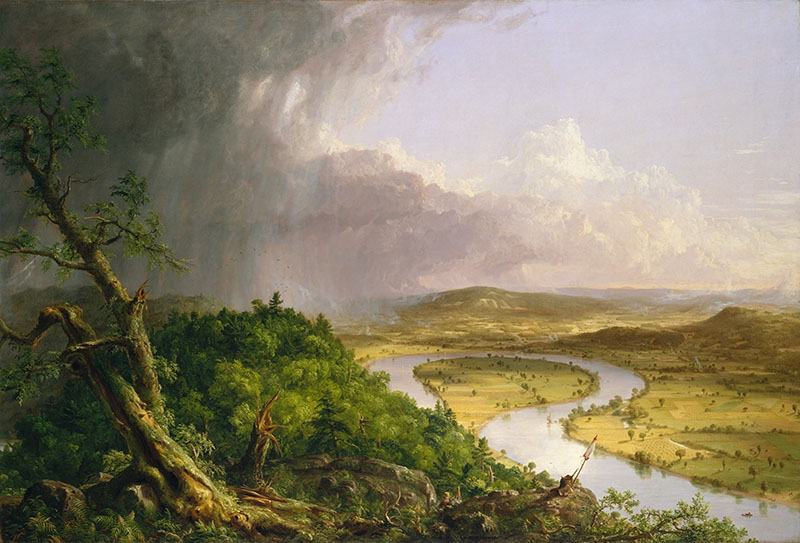Did Mary Baker Eddy care about the environment?

The Oxbow, View from Mount Holyoke, Northampton, Massachusetts, after a Thunderstorm, 1836, painting by Thomas Cole. Courtesy of Metropolitan Museum of Art.
During Eddy’s lifetime, “environmentalist” exclusively meant a person who believed in the influence of the environment over heredity—nurture over nature, in other words. The first use of the word “environmentalist” to mean one who cares for nature did not appear until 1916. In the nineteenth century, the word “naturalist” would have been closer to our understanding of today’s environmentalist, though it frequently had a secular implication—naturalists were often understood to look for explanations in the natural world instead of the spiritual one.
Even though Eddy doesn’t fit her era’s image of an environmentalist, she still cared deeply for the environment. She loved animals and nature, and believed that the beauty of the natural world was a reflection of the beauty and majesty of God.
Eddy spent the first fifteen years of her life on a farm in Bow, New Hampshire; her father, Mark Baker, cultivated almost five hundred acres of family land. Later in life, she would describe the spot nostalgically as “broad fields of bending grain waving gracefully, in the sunlight, and orchards of apples, peaches, pears, and cherries…green pastures bright with berries, singing brooklets, beautiful wild flowers, and…large flocks and herds.”1
She was especially fond of the animals on the farm. For more information on Eddy’s love of animals, please see this post: https://www.marybakereddylibrary.org/research/mary-baker-eddy-animals/
Eddy’s Pleasant View home in Concord, New Hampshire, was a working farm. In addition to pigs and cows, there was a large vegetable garden and an apple orchard. Workers, both from the household and local day laborers, picked and stored vegetables that were used in the kitchen. Neighbors were invited to glean more apples when the staff had picked enough for their needs. We know that peas, beets, potatoes, onions, asparagus, strawberries, apples, peaches, oats, rye, and hay were raised at various times thanks to Calvin Frye’s meticulous records. One field, called the “Jones field,” was planted with rye in 1901 and then harvested with the help of draft horses Nelly and Jerry. The field was plowed under the following year for pasture, but the rye from that one crop lasted until Eddy and her household left Pleasant View in 1908.2 Such subsistence activities were typical of households at the time; Eddy did not necessarily consider her home a farm, but a place of privacy and refuge, surrounded and supported by its land.
In addition to being well known for food crops, Pleasant View was also known for its flowers. There was a greenhouse on the property maintained by a florist in Concord, and each spring John Salchow and August Mann would plant vast beds of different flowers around the property, especially between the house and the barn. Salchow mentioned that Eddy especially loved roses, and that he took great pains to plant a “wonderful rose garden.” He was also proud of the tulip beds, and said that “half of Concord would come out to Pleasant View to see them—sometimes there were as many as three or four hundred people there during the day admiring the tulips.”3 There were also ornamental trees on the grounds; Eddy particularly admired a weeping willow by the fountain “which spread its branches like a green fan.”4
Eddy’s love of nature is also evident in her writings. She often used natural metaphors to explain her ideas. In Science and Health, she wrote:
Instinct is better than misguided reason, as even nature declares. The violet lifts her blue eye to greet the early spring. The leaves clap their hands as nature’s untired worshippers. The snowbird sings and soars amid the blasts; he has no catarrh from wet feet, and procures a summer residence with more ease than a nabob. The atmosphere of the earth, kinder than the atmosphere of mortal mind, leaves catarrh to the latter. Colds, coughs, and contagion are engendered solely by human theories.5
Later in Science and Health she expanded on the same metaphor:
Nature voices natural, spiritual law and divine Love, but human belief misinterprets nature. Arctic regions, sunny tropics, giant hills, winged winds, mighty billows, verdant vales, festive flowers, and glorious heavens,—all point to Mind, the spiritual intelligence they reflect. The floral apostles are hieroglyphs of Deity. Suns and planets teach grand lessons. The stars make night beautiful, and the leaflet turns naturally towards the light.6
Today, many in the world feel the love of the environment that Mary Baker Eddy showed so strongly throughout her life. In her cultivation of the fields at Pleasant View, you could even say she “ate local.” She wasn’t interested in buzzwords and trends, though—she was simply showing the same practical Yankee love of the world around her that characterized her entire life.

